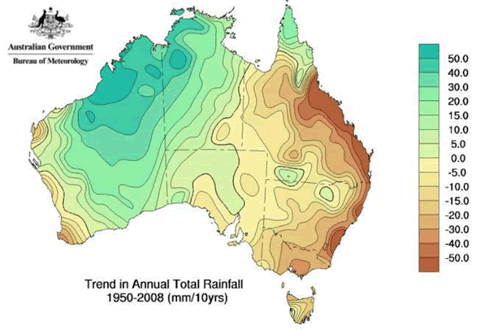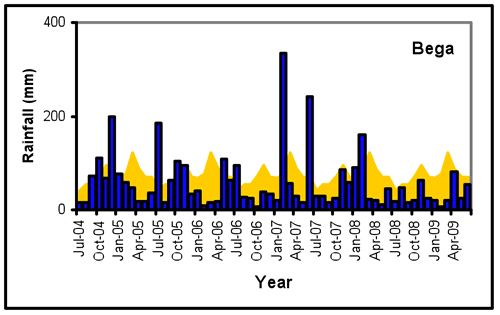Regional Snapshot - Water
Water – Managing with Less
Water is the source of all life according to Mark Twain, however, he also says that whisky is for drinking and water is for fighting! Either way water is essential in ensuring both our wellbeing and livelihood as well as sustaining the natural ecosystems upon which we depend. In the ACR, our water use is generally below the New South Wales (NSW) state average of 740,000 litres/person/year. As a comparison the average in the ACT is 840,00litres/person/year.1 However these figures are high compared with other statistics from the developed world.2
We face pressing challenges, driven by climate variability, reduced rainfall, population growth in some parts of the ACR and consumption patterns that increase the ongoing demand for water.
Over the last 50 years, rainfall in the region has decreased (refer Figure 1).
 |
Source: Bureau of Meteorology, 2009
The adverse trends appear to be continuing – for example Bega, in 2008/09, the rainfall was 54.4% below the long term average (see Figure 2).
 |
Source: Bureau of Meteorology, 2009
Reduced rainfall and an increase in population in pockets of the ACR (coastal areas and inland cities) has resulted in some of our water supply sources no longer being adequate. However this has also occurred in parts of the ACR where the population is declining. For example, Bombala was recently on severe Level 5 water restrictions and the main reservoir at Coolumbooka Weir had only enough water last the town approximately 80 or 90 days.3 In this case, Bombala responded by installing an emergency water supply pumping system.
The ACR is unique, in that we are the only Region which receives a substantial amount of our water from snow melt. However, our topography and rainfall patterns create challenges for maintaining our water supply. For example, the average annual rainfall of 750mm varies significantly across the region. It can be as high as 2000mm in the Snowy Mountains and as low as 600mm in the lower western slopes. 4
In addition to this, the NSW Department of Environment, Climate Change and Water predict that by 2050 regional summer rainfall may increase by 20-50% whilst winter rainfall may reduce by 10-50%.5 This fall in winter rain could lead to reductions in snow in the Snowy Mountains of up to 85-96% by 20506 with serious implications for ecology, hydrology, soils and economy throughout the Region. This will potentially have a significant impact on the region’s water supply.7
Planning for our future water resources needs to include demand management, as the environmental and social costs associated with developing new water supplies can be significant. In addition, demand management savings can be immediate whereas new sources take several years to investigate and develop. Water restrictions are a common tool in managing water demand, and have been implemented across the region to various levels depending on water availability. There are also opportunities to become more water efficient with more efficient appliances, stormwater harvesting and wastewater reuse.
Council Responses
Reductions in winter snow and rain will have significant effects on the economy and water availability in the region.8 Integrated water management, including demand management, therefore becomes important to ensure future supplies. An example of this approach is in Tumbarumba, where a Drought Mitigation Strategy was completed to ensure the Council has the fullest understanding of its current and future potable water resources.9
Councils also need to work collaboratively with their communities to reduce water demand.
Actions that can be undertaken to protect and enhance water resources include:
- Implementing an Integrated Water Management approach across Council, considering and encouraging non-potable supply from water harvesting (such as rainwater tanks and stormwater harvesting), grey water and recycling options.
- Continuing to work with the Catchment Management Authority (CMA) to conserve and sustain the catchment through effective catchment management.
- Continuing to work with relevant community groups and Traditional Owners to improve river health and reduce water consumption.
- Developing partnerships with farmers, the community and researchers to improve agricultural, residential, business and industrial water efficiencies.
- Investigating and understanding the volume and quality of groundwater available, to ensure that the sustainable yield (i.e. that the amount extracted is less than the recharge) is not overdrawn.
- Improving our understanding of the impacts that our urban areas have on waterways and developing planning processes and actions, such as Water Sensitive Urban Design, to mitigate potential impacts; this could include linking with school education programs such as the Australian Sustainable Schools Initiative (AuSSI), a national program10 which has been implemented in approximately 80% of Canberra schools.
References and Footnotes
1 Australian Conservation Foundation, 2009, “Consumption Atlas” viewed at http://www.acfonline.org.au/consumptionatlas/ABC News, 2009, viewed at http://www.abc.net.au/news/stories/2009/04/28/2554632.htm
2 www.waterfootprint.org
3 ABC News, 2009, viewed at http://www.abc.net.au/news/stories/2009/04/28/2554632.htm
5 DECCW, 2009, http://www.environment.nsw.gov.au/climateChange/government.htm
6 Garnaut, R, 2008 “The Garnaut Climate Change Review, Final Report” p 135, viewed at http://www.garnautreview.org.au/index.htm
7 Duggan and Garr, 2006, “Runoff Modelling for Snow-affected Catchments in the Snowy Mountains”.
8 OCSE Regional Sustainability Overview, 2008
9 Tumbarumba Shire Council, 2008, “Tumbarumba Drought Mitigation Strategy”, viewed at http://tumbashire.local-e.nsw.gov.au/environment/1124/3107.html
10See: http://www.environment.gov.au/education/sustainable-schools/index.html
